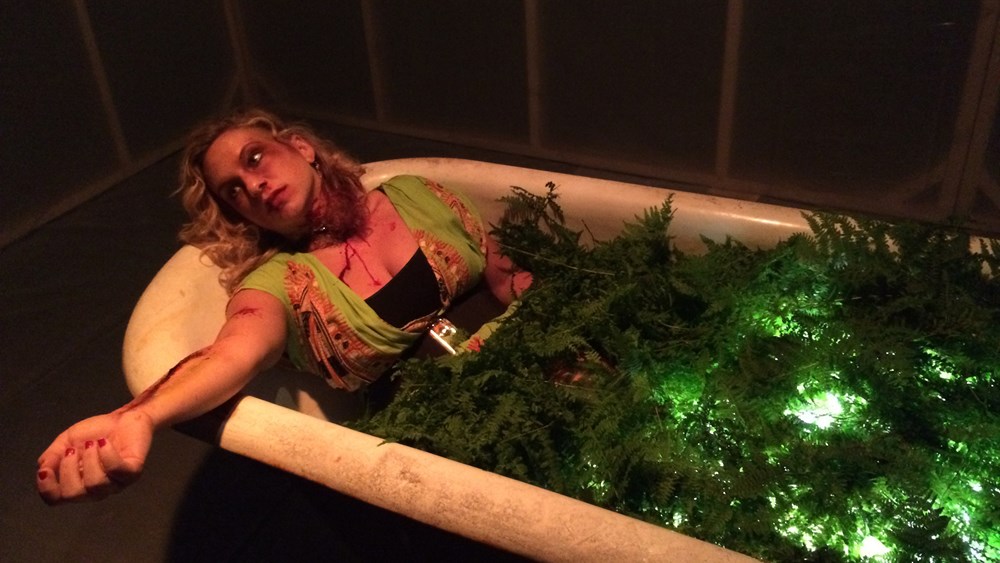Virtually Operatic
Although virtual reality — “VR” for short — has rapidly gained traction in the gaming and animation worlds, it is only just starting to play a role in the performing arts. Still, it makes perfect sense that the technology should be making inroads into the original multimedia art form: opera.
“The more I learned about VR, the more I felt like it was an ideal place to present an opera,” says Anne Hiatt, co-founder of the Brooklyn-based Opera on Tap, which has produced the episodic VR horror opera The Parksville Murders. Written by Kamala Sankaram and Jerre Dye, with video direction by Cari Ann Shim Sham, the work requires viewers to don a VR headset, with an Android-based smartphone inserted into it, along with headphones. The apparatus lets viewers track the paths of two young women (sopranos Kacey Cardin and Mikki Sodergren) who’ve awakened to find themselves in what appears to be a crime scene, with creepy, black-cloaked figures observing them.

Throughout the narrative, you can turn your head to view any part of the setting. Meanwhile, “spatialized audio” technology offers sound cues from different parts of the virtual landscape. The technology essentially allows viewers to shape their own journeys through the piece, based on where and when they turn their heads. “We loved the idea of a choose-your-own-adventure experience,” says Hiatt. “You can go back and rewatch the episode and see more of the story.”
Collaborating with the production company Light Sail VR, Opera on Tap has filmed the pilot episode of the series, which was honored in May at the NYC Independent Film Festival as best virtual reality video. Later this summer, the company plans to announce a distribution partner and share its plans for a series of future episodes, available on demand. “Binge-watching is what’s trending on television,” she says, “and that’s our idea of how this will work.”
Some companies are meanwhile using VR technology to enhance the traditional opera-going experience. Boston Lyric Opera has invested in a 360-degree camera, which it used to record a studio rehearsal of The Rake’s Progress and a dress rehearsal of The Marriage of Figaro, publishing the videos on Facebook and YouTube. “A lot of our regular fans were excited by it because they got to see what goes into a creating an opera,” says Jeila Irdmusa, BLO’s communications manager. “We also got a lot of buzz on Twitter just for the fact that virtual reality is so cool right now. It gets us attention from people who aren’t normally opera-goers.”
Although the idea of using VR to promote the world premiere of the Stewart Copeland work The Invention of Morel came from Chicago Opera Theater’s marketing department, the technology eventually drew in Jonathan Moore, the sci-fi opera’s co-librettist. He steered the team toward an expository scene that had been cut when the opera was in development. Partnering with the video and animation firm Reel Captivation, which donated its time and resources, COT brought the scene to life through an app that featured a VR tour of the opera’s island setting, along with a 360-degree video that could be watched without special goggles.
Upon arrival at the theater, audience members were shepherded into a special viewing room, where they sat in wooden boats (mimicking the imaginary one in the VR tour), put on goggles and watched the video. Their reactions? “Mostly it was people going, ‘Wow—that was an experience I had not had before, and it was one I was not expecting to have at the opera,’” says Douglas Clayton, COT’s general director designate. “It was a surprise and an adventure — and that’s the spirit of our company.”
This article was published in the Summer 2017 issue of Opera America Magazine.

Nicholas Wise
Nicholas Wise is OPERA America's senior manager of marketing and publications and the associate editor of Opera America Magazine.




